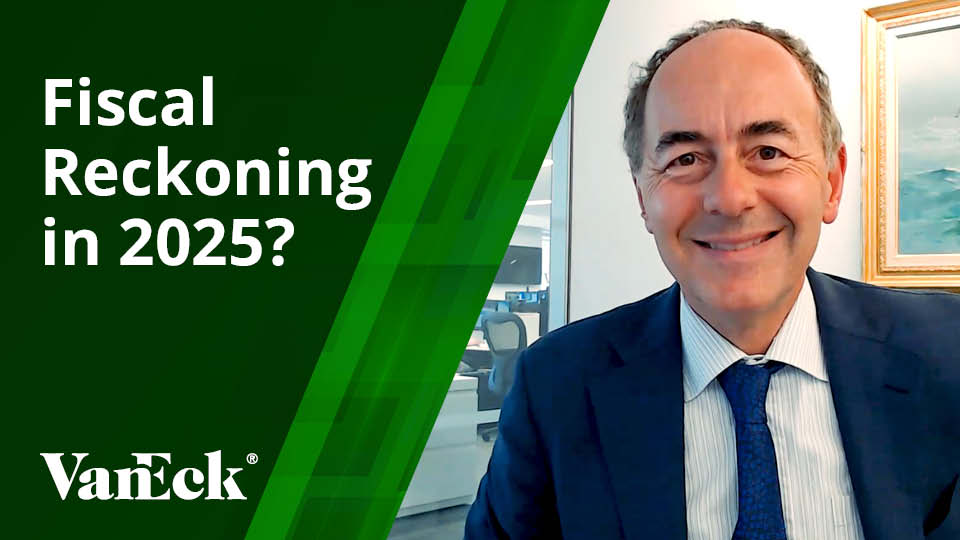Meet CEO Jan van Eck: From Macro Investor to Crypto Bull
September 20, 2023
Read Time 6 MIN
VanEck's rich history, grounded in macro investing and a unique investment philosophy, has shaped the company over the years. In this Q&A, CEO Jan van Eck shares his perspective on the firm’s journey, its investment strategies, and its foray into the world of cryptocurrencies.
- What do you think differentiates VanEck from other investment managers?
- What can investors learn from market history and how does your understanding of history shape your investment philosophy?
- When did you first notice Bitcoin?
- How should investors think about cryptocurrencies in their broader portfolio allocations?
- How will cryptocurrencies impact finance?
What do you think differentiates VanEck from other investment managers?
JAN VAN ECK: Our investment approach revolves around macro trends that impact financial markets. Unlike many investment firms that focus on specific stocks or sectors, we take a broader view, examining global trends such as wars, political instability, and technological advancements.
In a nutshell, we examine big global trends and evaluate how they will impact financial markets, as well as the potential opportunities and risks they create for investment portfolios. For example, the firm was founded on the premise that, particularly after World War II, international stocks — specifically from Europe, Germany, and Japan, as well as Asia — were growing at a faster rate. So there was significant growth potential in this area that had not fully entered the mainstream of traditional markets and therefore, was not a part of most investor portfolios.
But as macro investors we also have to make sure we’re looking at pervasive risks that might be under the radar. In 1968, the U.S. was performing well economically, but there were concerns about its large government spending policies and the rapid expansion of its money supply. My father, John van Eck, foresaw the risk of inflation in the U.S. and started looking for ways to hedge against that risk—one unusual option at that time, given its fixed price, was investing in gold.
One point to remember is how different the future can look from what you might imagine. No one thought the price of gold could reach anywhere close to today’s levels. This kind of dramatic change is often not on people's radar unless they have a historical perspective that allows them to entertain a wide range of possibilities.
Speaking of historical perspective, we know you are a big history buff. What can investors learn from market history and how does your understanding of history shape your investment philosophy?
VAN ECK: Predicting the future is difficult, but articulating potential outcomes and likelihood is a reasonable exercise. History can suggest an array of government policies and economic outcomes that may not be obvious at a point in time. History can also tell us a lot about the path of current trends.
For example, railroads, a vital technology of their time, were essentially complete around the 1860s in the U.S. However, there was a substantial increase in the market cap and stock prices of these companies before their full implementation. Investors correctly anticipated the potential profits from this new technology, but there’s risk in being too early. Even if your fundamental premise is correct, you can still experience significant losses. Railroad stocks peaked before 1860 and subsequently fell by over 50 percent, despite the continued development of the technology.
I reference this history when discussing cryptocurrencies, as a lesson from the past that holds relevance even today. Like railroads, cryptocurrencies could potentially be highly disruptive. However, being cautious of the volatile investment cycles is essential. Even if your investment thesis is correct, you could still lose money as an investor, making it a cautionary tale worth remembering.
When did you first notice Bitcoin?
VAN ECK: In 2017, I dove deep into the world of Bitcoin. As you can imagine, even in 2017, there were plenty of skeptics. I sought opinions from my colleagues, but they didn't have much insight into this emerging asset at the time. By listening to podcasts and reading white papers, I was able to develop a solid understanding of the technology behind cryptocurrencies. Although I'm not a computer scientist, I am familiar with how computers and databases are structured, which helped.
Following this research, I concluded that Bitcoin indeed had the potential to rival gold. That was when we embarked on the project to file for one of the first Bitcoin ETFs in the U.S.
How should investors think about cryptocurrencies in their broader portfolio allocations?
VAN ECK: I believe there a different facets of cryptocurrencies overall and depending on what specifically is being discussed can fit into different parts of an investor’s portfolio. It's crucial to clarify that what I'm about to share cannot be empirically proven, because we can't predict the future. This is more of a mental model that guides my thinking.
Firstly, Bitcoin acts as a competitor or companion to gold. This is due to its scarcity value, which mirrors that of gold—indestructible not because of physical limits (like the finite amount of gold in the ground) but because of the algorithms underlying Bitcoin. So, it represents a store of value and offers protection against inflation.
Secondly, beyond Bitcoin, other cryptocurrencies represent applications akin to any other type of growth or technology investment. Be it healthcare, science, databases, cloud computing, 5G or 6G, these cryptocurrencies play a similar role. Say you own 50 stocks, with a split of 25 for growth and 25 for value. I would include a small allocation to these crypto related applications in that overall growth exposure.
In both cases, I believe you need it as a hedge to your financials and technology equity exposure. So, in a sense, similar to how Argentinians would rather hold U.S. dollar-linked stablecoins than the Argentinian peso that has almost 100% inflation, in your growth portfolio you'd like to have some allocation to a technology that could be a significant disruptor.
How will cryptocurrencies impact finance?
VAN ECK: The financial ecosystem has transitioned from being run by paper in the 1950s to programmed mainframe computers in the 1970s. Now, we’re facing the question of whether a decentralized financial ecosystem can be built.
My main concern is around the fragmentation of the financial system. Major financial institutions are working on blockchain applications, but private blockchains would be no different than having private mainframes. Also, regulatory bodies are moving at different speeds. Europe and Brazil, for instance, are advancing towards adopting tokenization and blockchain technologies to reduce costs for investors, while other countries like the U.S. are at a standstill.
Things are changing, and we need to recognize that. We can't predict how they will evolve, but we must stay aware and open to these developments.
To receive more Investment Outlook insights, sign up in our subscription center.
Related Topics
Related Insights
April 17, 2024
DISCLOSURES
Bitcoin (BTC) is a decentralized digital currency, without a central bank or single administrator, that can be sent from user to user on the peer-to-peer bitcoin network without the need for intermediaries.
Please note that VanEck may offer investments products that invest in the asset class(es) or industries included in this communication.
This is not an offer to buy or sell, or a recommendation to buy or sell any of the securities, financial instruments or digital assets mentioned herein. The information presented does not involve the rendering of personalized investment, financial, legal, tax advice, or any call to action. Certain statements contained herein may constitute projections, forecasts and other forward-looking statements, which do not reflect actual results, are for illustrative purposes only, are valid as of the date of this communication, and are subject to change without notice. Actual future performance of any assets or industries mentioned are unknown. Information provided by third party sources are believed to be reliable and have not been independently verified for accuracy or completeness and cannot be guaranteed. VanEck does not guarantee the accuracy of third party data. The information herein represents the opinion of the author(s), but not necessarily those of VanEck or its other employees.
Investments in digital assets and Web3 companies are highly speculative and involve a high degree of risk. These risks include, but are not limited to: the technology is new and many of its uses may be untested; intense competition; slow adoption rates and the potential for product obsolescence; volatility and limited liquidity, including but not limited to, inability to liquidate a position; loss or destruction of key(s) to access accounts or the blockchain; reliance on digital wallets; reliance on unregulated markets and exchanges; reliance on the internet; cybersecurity risks; and the lack of regulation and the potential for new laws and regulation that may be difficult to predict. Moreover, the extent to which Web3 companies or digital assets utilize blockchain technology may vary, and it is possible that even widespread adoption of blockchain technology may not result in a material increase in the value of such companies or digital assets.
Digital asset prices are highly volatile, and the value of digital assets, and the companies that invest in them, can rise or fall dramatically and quickly. If their value goes down, there’s no guarantee that it will rise again. As a result, there is a significant risk of loss of your entire principal investment.
Digital assets are not generally backed or supported by any government or central bank and are not covered by FDIC or SIPC insurance. Accounts at digital asset custodians and exchanges are not protected by SPIC and are not FDIC insured. Furthermore, markets and exchanges for digital assets are not regulated with the same controls or customer protections available in traditional equity, option, futures, or foreign exchange investing.
Digital assets include, but are not limited to, cryptocurrencies, tokens, NFTs, assets stored or created using blockchain technology, and other Web3 products.
Web3 Companies include but are not limited to, companies that involve the development, innovation, and/or utilization of blockchain, digital assets, or crypto technologies.
All investing is subject to risk, including the possible loss of the money you invest. As with any investment strategy, there is no guarantee that investment objectives will be met and investors may lose money. Diversification does not ensure a profit or protect against a loss in a declining market. Past performance is no guarantee of future results.
© Van Eck Securities Corporation, Distributor, a wholly owned subsidiary of Van Eck Associates Corporation.
DISCLOSURES
Bitcoin (BTC) is a decentralized digital currency, without a central bank or single administrator, that can be sent from user to user on the peer-to-peer bitcoin network without the need for intermediaries.
Please note that VanEck may offer investments products that invest in the asset class(es) or industries included in this communication.
This is not an offer to buy or sell, or a recommendation to buy or sell any of the securities, financial instruments or digital assets mentioned herein. The information presented does not involve the rendering of personalized investment, financial, legal, tax advice, or any call to action. Certain statements contained herein may constitute projections, forecasts and other forward-looking statements, which do not reflect actual results, are for illustrative purposes only, are valid as of the date of this communication, and are subject to change without notice. Actual future performance of any assets or industries mentioned are unknown. Information provided by third party sources are believed to be reliable and have not been independently verified for accuracy or completeness and cannot be guaranteed. VanEck does not guarantee the accuracy of third party data. The information herein represents the opinion of the author(s), but not necessarily those of VanEck or its other employees.
Investments in digital assets and Web3 companies are highly speculative and involve a high degree of risk. These risks include, but are not limited to: the technology is new and many of its uses may be untested; intense competition; slow adoption rates and the potential for product obsolescence; volatility and limited liquidity, including but not limited to, inability to liquidate a position; loss or destruction of key(s) to access accounts or the blockchain; reliance on digital wallets; reliance on unregulated markets and exchanges; reliance on the internet; cybersecurity risks; and the lack of regulation and the potential for new laws and regulation that may be difficult to predict. Moreover, the extent to which Web3 companies or digital assets utilize blockchain technology may vary, and it is possible that even widespread adoption of blockchain technology may not result in a material increase in the value of such companies or digital assets.
Digital asset prices are highly volatile, and the value of digital assets, and the companies that invest in them, can rise or fall dramatically and quickly. If their value goes down, there’s no guarantee that it will rise again. As a result, there is a significant risk of loss of your entire principal investment.
Digital assets are not generally backed or supported by any government or central bank and are not covered by FDIC or SIPC insurance. Accounts at digital asset custodians and exchanges are not protected by SPIC and are not FDIC insured. Furthermore, markets and exchanges for digital assets are not regulated with the same controls or customer protections available in traditional equity, option, futures, or foreign exchange investing.
Digital assets include, but are not limited to, cryptocurrencies, tokens, NFTs, assets stored or created using blockchain technology, and other Web3 products.
Web3 Companies include but are not limited to, companies that involve the development, innovation, and/or utilization of blockchain, digital assets, or crypto technologies.
All investing is subject to risk, including the possible loss of the money you invest. As with any investment strategy, there is no guarantee that investment objectives will be met and investors may lose money. Diversification does not ensure a profit or protect against a loss in a declining market. Past performance is no guarantee of future results.
© Van Eck Securities Corporation, Distributor, a wholly owned subsidiary of Van Eck Associates Corporation.



